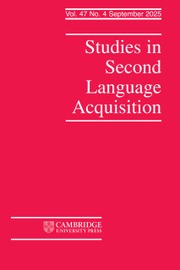Crossref Citations
This article has been cited by the following publications. This list is generated based on data provided by
Crossref.
Ellis, Nick C.
2012.
Formulaic Language and Second Language Acquisition: Zipf and the Phrasal Teddy Bear.
Annual Review of Applied Linguistics,
Vol. 32,
Issue. ,
p.
17.
Chlapana, Elissavet
and
Tafa, Eufimia
2014.
Effective practices to enhance immigrant kindergarteners’ second language vocabulary learning through storybook reading.
Reading and Writing,
Vol. 27,
Issue. 9,
p.
1619.
Gettys, Serafima
2014.
Cases on Communication Technology for Second Language Acquisition and Cultural Learning.
p.
412.
Linck, Jared A.
Osthus, Peter
Koeth, Joel T.
and
Bunting, Michael F.
2014.
Working memory and second language comprehension and production: A meta-analysis.
Psychonomic Bulletin & Review,
Vol. 21,
Issue. 4,
p.
861.
Gor, Kira
2014.
The Encyclopedia of Applied Linguistics.
p.
1.
Kwok, Rosa K. W.
and
Ellis, Andrew W.
2014.
Visual word learning in adults with dyslexia.
Frontiers in Human Neuroscience,
Vol. 8,
Issue. ,
Gettys, Serafima
2014.
Computational Linguistics.
p.
1658.
Kapa, Leah L.
and
Colombo, John
2014.
Executive function predicts artificial language learning.
Journal of Memory and Language,
Vol. 76,
Issue. ,
p.
237.
Kwok, Rosa Kit Wan
and
Ellis, Andrew W.
2015.
Visual word learning in skilled readers of English.
Quarterly Journal of Experimental Psychology,
Vol. 68,
Issue. 2,
p.
326.
SONBUL, SUHAD
2015.
Fatal mistake, awful mistake, or extreme mistake? Frequency effects on off-line/on-line collocational processing.
Bilingualism: Language and Cognition,
Vol. 18,
Issue. 3,
p.
419.
Grey, Sarah
Cox, Jessica G.
Serafini, Ellen J.
and
Sanz, Cristina
2015.
The Role of Individual Differences in the Study Abroad Context: Cognitive Capacity and Language Development During Short‐Term Intensive Language Exposure.
The Modern Language Journal,
Vol. 99,
Issue. 1,
p.
137.
Hamrick, Phillip
2015.
Declarative and procedural memory abilities as individual differences in incidental language learning.
Learning and Individual Differences,
Vol. 44,
Issue. ,
p.
9.
Archibald, Lisa M.D.
Levee, Tyler
and
Olino, Thomas
2015.
Attention allocation: Relationships to general working memory or specific language processing.
Journal of Experimental Child Psychology,
Vol. 139,
Issue. ,
p.
83.
Verhagen, Josje
Leseman, Paul
and
Messer, Marielle
2015.
Phonological Memory and the Acquisition of Grammar in Child L2 Learners.
Language Learning,
Vol. 65,
Issue. 2,
p.
417.
Linck, Jared A.
and
Weiss, Daniel J.
2015.
Can Working Memory and Inhibitory Control Predict Second Language Learning in the Classroom?.
Sage Open,
Vol. 5,
Issue. 4,
Hummel, Kirsten M.
and
French, Leif M.
2016.
Phonological memory and aptitude components: Contributions to second language proficiency.
Learning and Individual Differences,
Vol. 51,
Issue. ,
p.
249.
Verhagen, Josje
and
Leseman, Paul
2016.
How do verbal short-term memory and working memory relate to the acquisition of vocabulary and grammar? A comparison between first and second language learners.
Journal of Experimental Child Psychology,
Vol. 141,
Issue. ,
p.
65.
Kim, Sun-A
Packard, Jerome
Christianson, Kiel
Anderson, Richard C.
and
Shin, Jeong-Ah
2016.
Orthographic consistency and individual learner differences in second language literacy acquisition.
Reading and Writing,
Vol. 29,
Issue. 7,
p.
1409.
Yalçın, Şebnem
Çeçen, Sevdeğer
and
Erçetin, Gülcan
2016.
The relationship between aptitude and working memory: an instructed SLA context.
Language Awareness,
Vol. 25,
Issue. 1-2,
p.
144.
Jackson, Daniel O.
2016.
Cognitive Individual Differences in Second Language Processing and Acquisition.
Vol. 3,
Issue. ,
p.
157.


